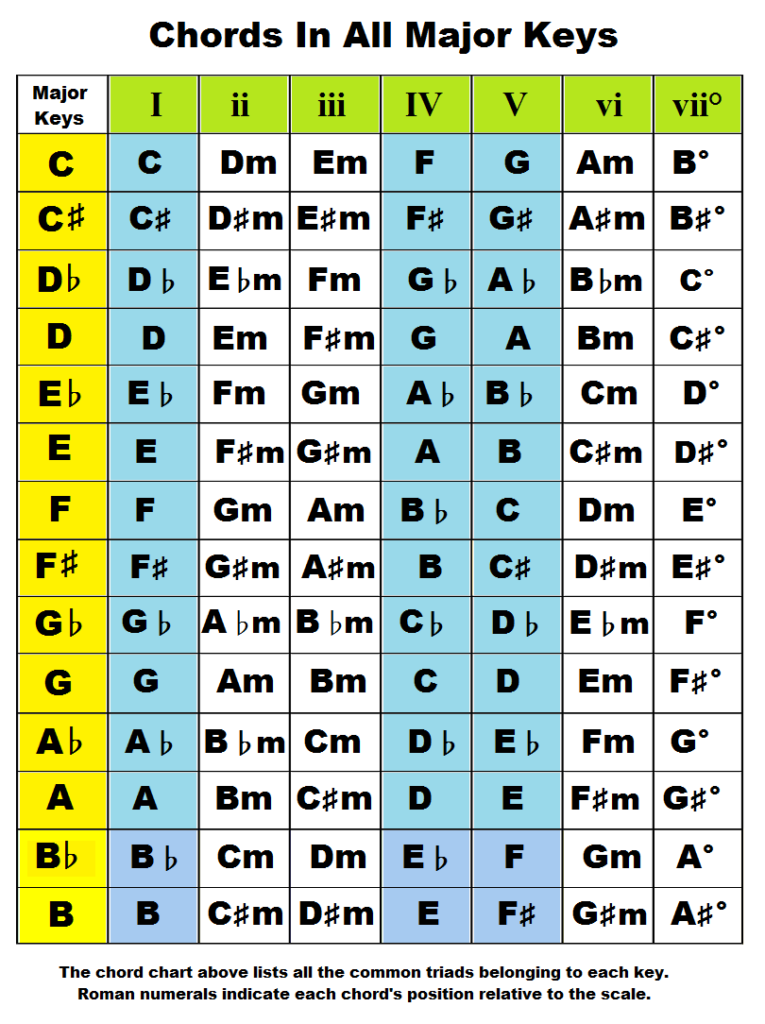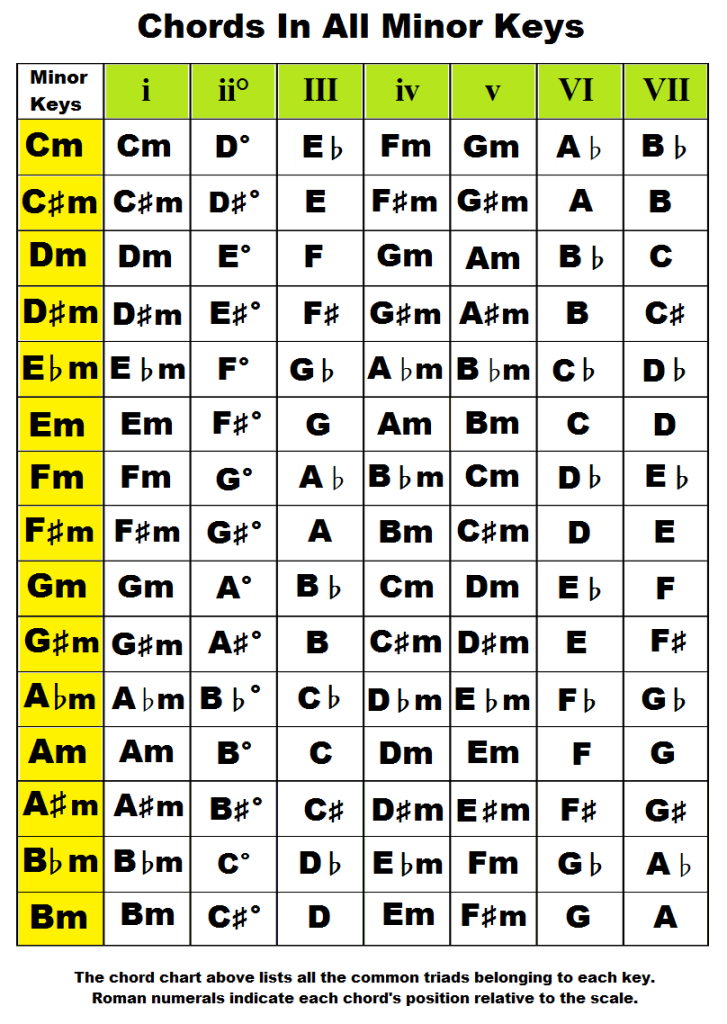Chords by key… Chords in the key of… What chords are in what key? Piano Chords Charts. (For guitar players as well.)
In this section, we shall take a look at chords sorted by key. We will take a look at chords in the keys of C, C sharp, D flat, D, E flat, E, F, F sharp, G flat, G, G sharp, A flat, A, A sharp, B flat and B major and minor. All keys!
To learn more about chords, check out my course, Piano Chords: How To Form Basic Chords On Piano And Keyboard. (Master The Most Common Piano Chords With The Help Of An Experienced Piano Player).
What are the scales that correspond to each key? We will learn the major and minor scales, respectively for the various keys.
How about the key signatures for each key? We will take a look at this as well. We will learn the number of sharps and flats in each key and what the sharp or flat notes are. Key signature diagrams are included.
We will take a look at various chord diagrams, listing all the triad and four note chords in each key.
How Does One Come Up With The Chords In Each Key?
Before we take a look at the various chords by key, we will try to have a clear understanding of how one comes up with the chords in each key.
Quickly, as an example, the chords in the key of C are C major, D minor, E minor, F major, G major, A minor and B diminished. One can add sevenths to all of these chords and this would give us Cmaj7, Dmin7, Emin7, Fmaj7, G7, Amin7 and Bm7b5. The question is “How did we come up with these chords?”
The chord names follow the notes in the scale.
For instance in the C major scale the notes are C D E F G A B C. The chords in the key of C must be named after each of the seven notes. In other words, each note must have a chord that corresponds to it. The chords can be either major, minor or diminished and the notes that form each chord must be part of the major scale.
Highly Recommended: Click here for the BEST piano/keyboard course I’ve come across online.
Maj, min and dim chords by key (major keys):

Major Keys Chord Pattern
The pattern of chords for major keys is major minor minor major major minor diminished. For the 1st, 4th and 5th notes of the major scale, the chords used are major chords, for the 2nd, 3rd and 6th notes you use minor chords and for the 7th note, you play a diminished chord. By the way, I created this amazing course that will help you with your chords. Check out “Piano Chords: How To Form Basic Chords On Piano And Keyboard”.
Piano Chords By Key: It’s Easy To Know What Chords To Play.
The fact that every note of each chord must be part of the major scale, makes it easy to know what chords to play. For instance, let’s start on the note C. The chord to play is C major and that’s obvious since the key is based on that chord. But let’s move to D. We can’t play D major because F# is not part of the scale and we can’t play D diminished either since this chord also makes use of flats (or black keys) that are not in the scale. The correct chord has to be D minor consisting of the notes D, F and A which are all part of the C major scale.
If we move to the note F, what chord must we play? It can’t be F minor because there is no black key in the C major scale and Ab is not part of the scale. Clearly, it can’t be F diminished either. It has to be F major consisting of the notes F A C.
Let’s go to the note B. What chord should we play? B major? B minor? B diminished? Clearly the answer is B diminished because this is the only chord that we can start on that key that includes notes which are all part of the C major scale.
The same applies when deciding what type of seventh chord to play. The 7th note must be part of the scale. For example, the first chord is Cmaj7 (C E G B) while the second chord in the key of C is Dm7 (D F A C). The chord corresponding to the note, B is Bm7b5 (B minor seventh flat five, also called B half diminished). The seventh chords in the key of C are Cmaj7, Dmin7, Emin7, Fmaj7, G7, Amin7 and Bm7b5.
The pattern goes as follows:
- maj7
- min7
- min7
- maj7
- dom7
- min7
- min7(b5)
Maj, min and dim chords by key (minor keys):
To learn more about chords by key (what chords are in what key and why), check out my book, Master Piano Chords By Key And Give Yourself A Big Advantage When Playing, Learning Or Writing Songs.

Minor Keys Chords Pattern
How about minor keys?
The pattern of chords for any minor key is minor, diminished, major, minor, minor, major, major. Using the key of A minor as an example, whose notes are A B C D E F G, the chords in the key of A minor in order are A minor, B diminished, C major, D minor, E minor, F major and G major. Clearly, every chord makes use of notes that are part of the scale.
Likewise, to form seventh chords, make sure that the note you pick is part of the scale. For example, the first chord in the key of A minor is Am7 (A C E G), but the second chord is NOT Bm7, but rather, Bm7b5 (B D F A). As another example, the chord for the note, F is F major seventh and NOT F dominant seventh, because Eb is not part of the scale, while E is. So the chords in the key of A minor with sevenths added are Amin7, Bm7b5, Cmaj7, Dmin7, Emin7, Fmaj7 and G7.
The pattern goes as follows:
- min7
- min7(b5)
- maj7
- min7
- min7
- maj7
- dom7
As long as you start by learning the scale, you shouldn’t have any problem knowing what chords to play. The keys of A minor and C major are perhaps the easiest because on piano, the keys for the notes of these two scales are all white.
Let’s take a look at the various keys and the chords they consist of.
Chords By Key – Major Keys
Major, minor, diminished, major seventh, dominant seventh, minor seventh and minor 7th flat five chords by key:
- Chords In The Key of C
- Chords In The Key of C sharp
- Chords In The Key of Db
- Chords In The Key of D
- Chords In The Key of D sharp
- Chords In The Key of Eb
- Chords In The Key of E
- Chords In The Key of F
- Chords In The Key of F#
- Chords In The Key of Gb
- Chords In The Key of G
- Chords In The Key of G#
- Chords In The Key of Ab
- Chords In The Key of A
- Chords In The Key of A#
- Chords In The Key of Bb
- Chords In The Key of B
Chords By Key – Minor Keys
Major, minor, diminished, major seventh, dominant seventh, minor seventh and minor 7th flat five chords by key:
- Chords In The Key of C minor
- Chords In The Key of C sharp minor
- Chords In The Key of D minor
- Chords In The Key of D sharp minor
- Chords In The Key of E Flat minor
- Chords In The Key of E minor
- Chords In The Key of F minor
- Chords In The Key of F# minor
- Chords In The Key of G minor
- Chords In The Key of G# minor
- Chords In The Key of Ab minor
- Chords In The Key of A minor
- Chords In The Key of A# minor
- Chords In The Key of Bb minor
- Chords In The Key of B minor
A common way to number these chords is by Roman numerals: I, ii, iii, IV, V, vi, vii°. Numerals that represent a major chord are usually capitalized, and minor and diminished chords are lower case. Roman numerals indicate each chord’s position relative to the scale.
Common chord progressions in major keys are:
- I – IV – V
- I – vi – IV – V
- ii – V – I
In the key of F, for example, this represents the chord progressions:
- F – Bb – C
- F – Dm – Bb – C
- Gm7 – C7 – Fmaj7
Common chord progressions in minor keys are:
- i – VI – VII
- i – iv – VII
- i – iv – v
- i – VI – III – VII
- ii – v – i
In the key of Emin for example, the above represents the chord progressions:
- Em – C – D
- Em – Am – D
- Em – Am – Bm
- Em – C – G – D
- F#m7b5 – Bm – Em
Knowing the chords in each key is a very important part of learning to play songs as well as songwriting. However, very often, a song may be in a particular key and some of the chords may come from another key. In this lesson we are in no way saying that the chords presented in this section are the only chords that should be played when a song is in a certain key. If this were the case, music would be quite boring after a while. But you must have an understanding of the chords in that particular key first of all. You need to start with this solid foundation of knowing what chords are in the various keys. So keep studying, keep learning and keep practicing.
For more information on piano chords go here: How To Build Piano Chords. You will find lots of pages with chord charts, diagrams, lessons and articles.
Click here to learn about my top recommendation for learning to play piano.